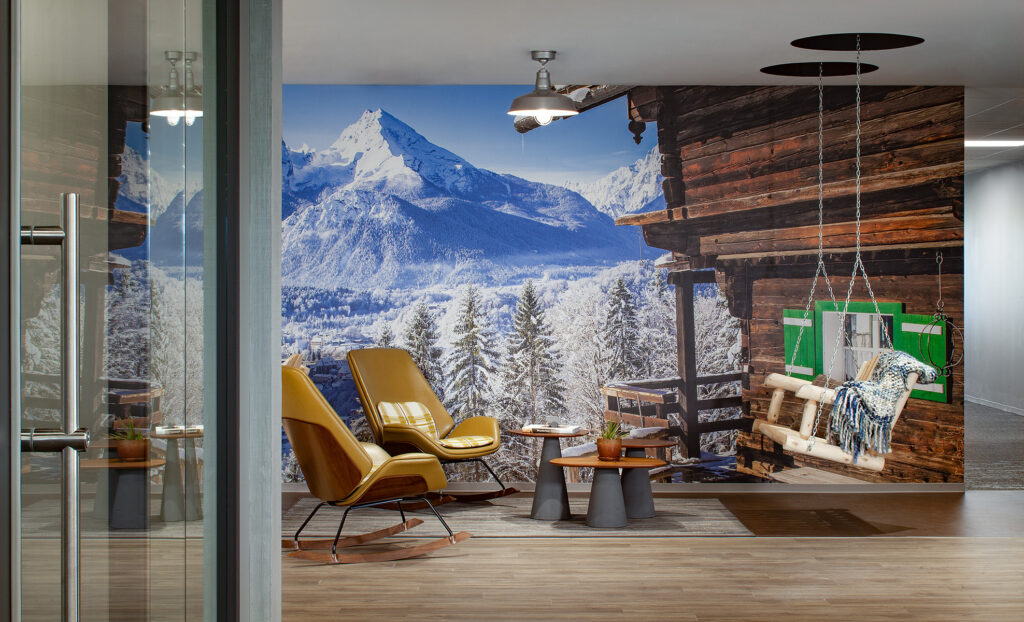Workplaces are no longer places where we simply clock in and out—they’re dynamic environments where ideas flow and relationships take root. In these spaces, collaboration thrives, and design plays a powerful role in shaping not only how people work, but how they feel.
Structure—the built environment—helps spaces flex and evolve alongside cultural shifts. It includes everything from spatial layout and acoustics to lighting, furniture, and the placement of shared resources. It provides the physical framework that helps teams stay aligned and effective through change. But structure alone isn’t enough. Sense—the intangible foundation shaped by culture and trust—defines how employees experience the workplace day to day. It brings meaning to the physical environment, ensuring that even as work evolves, people feel supported, connected, and grounded.
As INTEC Project Manager Ali Strawser puts it, “Having a strong sense of culture can help an organization withstand structural changes.” In other words, structure may set the foundation, but sense holds it together. When the two align, the result is a workplace that turns routine into meaning and enables teams to navigate change with confidence and purpose.
As INTEC Project Manager Ali Strawser puts it, “Having a strong sense of culture can help an organization withstand structural changes.” In other words, structure may set the foundation, but sense holds it together. When the two align, the result is a workplace that turns routine into meaning and enables teams to navigate change with
"Having a strong sense of culture can help an organization withstand structural changes."
confidence and purpose.
"Having a strong sense of culture can help an organization withstand structural changes."
This article explores how design shapes that bridge across three essential priorities: human connection, flexibility, and generational needs. Through the lenses of community, privacy & collaboration, well-being, technology, and empathetic leadership, we’ll explore how intentional environments can be crafted for function and belonging.
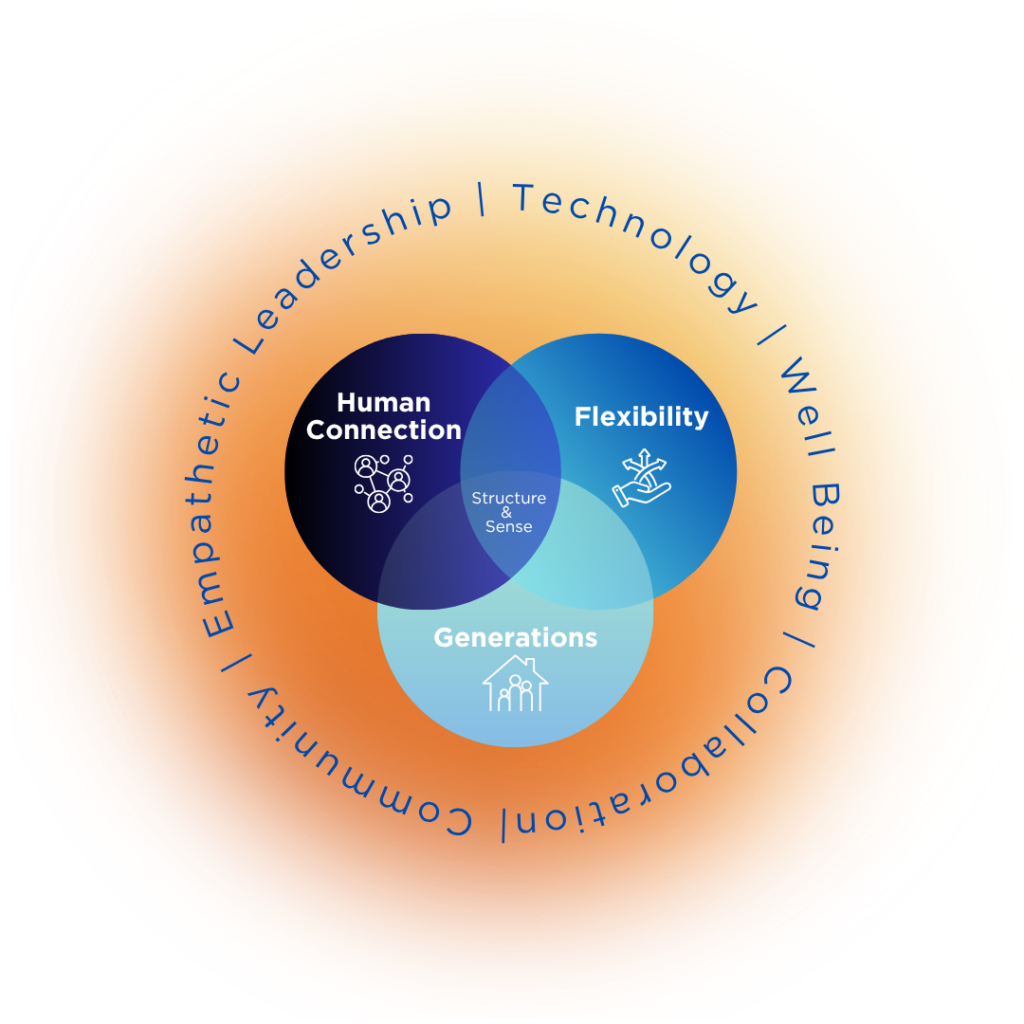

COMMUNITY: BUILDING BRIDGES THROUGH COMMUNITY
A vibrant workplace community isn’t defined by shared seating charts or monthly meetups; it’s built on relationships that span generations. Instead of focusing on age-based assumptions, the most inclusive workplaces emphasize individuals and what they contribute. Programs like mutual and reverse mentorship serve as natural connectors: younger employees share digital fluency and fresh perspective, while seasoned colleagues contribute hard-earned experience and institutional knowledge. Together, these relationships spark a two-way exchange built on mutual respect and shared growth.
But meaningful connection doesn’t happen on a set schedule; it happens when people can engage authentically, in ways that feel natural. Some may prefer structured mentorship, while others connect through casual hallway conversations or impromptu chats in the café. When employees have the freedom to choose how they build relationships—formally or informally, virtually or in person—community becomes more than an ideal; it becomes a lived part of the workday.
Structure plays a key role in enabling these moments. By applying the concept of neighborhoods, inspired by urban planning, workplaces can function like mini cities: collaboration zones that echo downtown gathering spaces, quiet work areas that mirror libraries, rejuvenation spaces that evoke parks, and continuous learning areas that feel like academic hubs. These distinct zones create a sense of place while supporting different types of interaction, offering employees both variety and autonomy in how they engage.
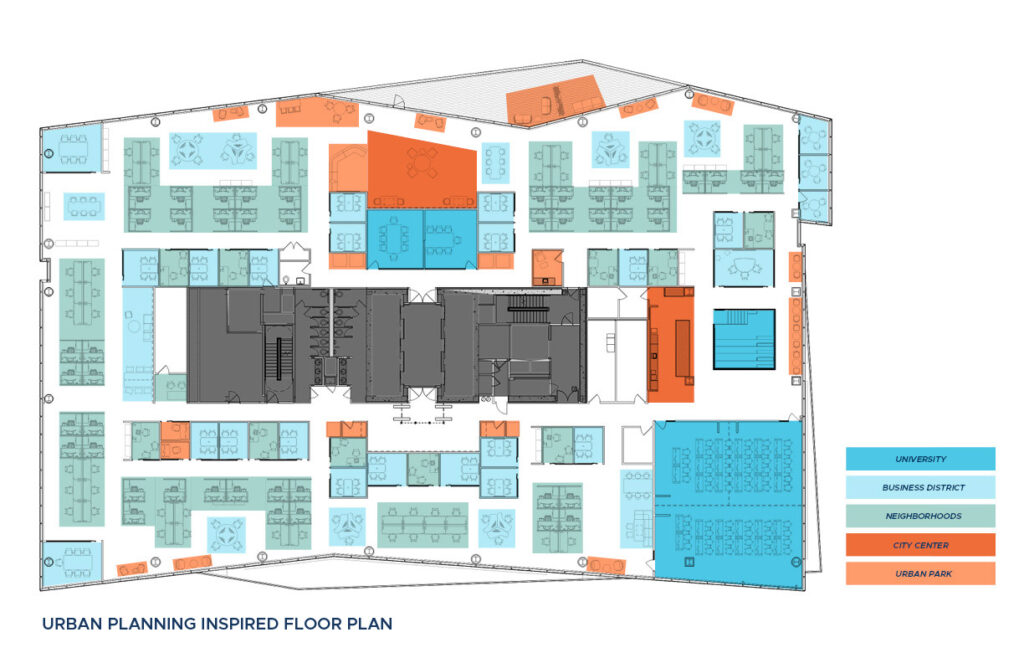
At the same time, sense reinforces a culture of belonging where employees feel recognized not just for their roles, but for their voice and value, regardless of age or title. When the physical and emotional layers of workplace culture align, connection doesn’t need to be forced; it happens naturally because the environment supports it.
PRIVACY & COLLABORATION: DESIGNING FOR BOTH INDEPENDENCE AND INTERACTION
The best workplaces recognize people do their best work when they can move fluidly between solo focus and shared collaboration. It’s less about desks and doors, and more about creating a rhythm that mirrors how people naturally work: time to think, time to connect, and time to recharge. This rhythm benefits from both balance—in the arrangement of space—and harmony—in the freedom to choose.
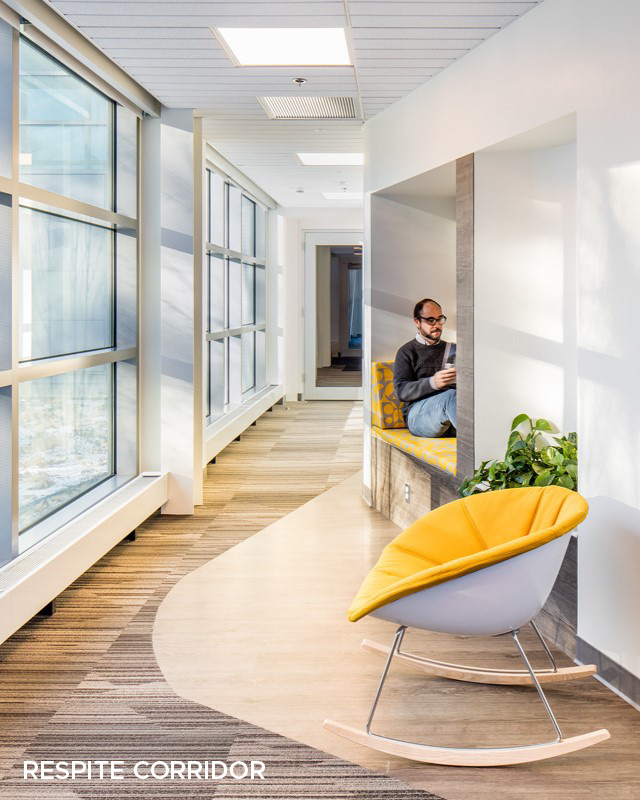
Structure creates balance through physical choices: dedicated rooms for deep work, open zones for team interaction, and in-between areas like cafés or soft seating lounges for casual conversation. These spaces allow employees to shift based on task, energy level, or stage of life. A parent managing a packed schedule might prefer quiet, focused space, while a new team member may seek collaboration to build relationships.
Generational preferences can also influence how people use space—Boomers and Gen X may lean toward quieter spaces, Millennials and Gen Z toward interactive ones—but these are tendencies, not rules. But the goal isn’t to cater to categories; it’s to give people options. Choice is what empowers everyone to do their best work, no matter their age, personality, or priorities.
That’s where sense comes in. While structure sets the stage, sense creates harmony that makes people feel confident navigating it. It’s quiet permission to unplug or join in, without hesitation. Balance may come from design, but harmony is created through intangibles like empathy, trust, and culture. When privacy and collaboration are designed with care, the result isn’t just greater productivity—it’s stronger teams.
WELL-BEING: DESIGNING FOR THE WHOLE PERSON, ACROSS EVERY GENERATION
With five generations now sharing the workplace, each shaped by distinct life experiences, and values, well-being has become a universal priority. From Traditionalists to Gen Z, people want to feel good at work, not just get work done. And while the definition of well-being may vary, its importance is universal.
In the past, work and personal life were often kept separate. Today, those lines are blurred. Employees expect more than a paycheck; they want a workplace that reflects their values and supports their health and growth. A truly supportive workplace meets employees where they are and evolves as their needs do.
This shift is especially relevant for younger generations. Research shows that Millennials—who made up 50% of the workforce by 2020*—are more likely to choose employers that prioritize well-being. Without that commitment, companies risk losing not just talent, but a large and growing segment of the workforce. As Gen Z continues to enter the workforce with similar values, the expectation for supportive, people-centered environments will only strengthen.
Structure plays a critical role in this. Healthy environments stem from more than good intentions; they’re built into the design. Biophilic elements, ergonomic furnishings, natural light, fresh air, and quiet zones all contribute to physical and mental wellness. Certifications like WELL and Fitwel offer benchmarks, but the goal is simple: create environments that help people feel and function at their best.
Flexibility and well-being go hand-in-hand. This means shifting away from space-centric planning and toward people-centric design, where the workplace adapts to the needs of its people, not the other way around. When employees can shape their day on their terms, they feel more in control and stress becomes easier to manage. And when nine in ten employees* say workplace stress impacts their mental health, adaptable environments are essential.
This is where sense steps in. Beyond the layout, well-being is shaped by the emotional tone of the workplace. It’s not about coffee bars and pool tables. It’s about a workplace where people can step away, set boundaries, and be themselves. When structure and sense align, well-being becomes more than a wellness initiative. It becomes part of the everyday experience.
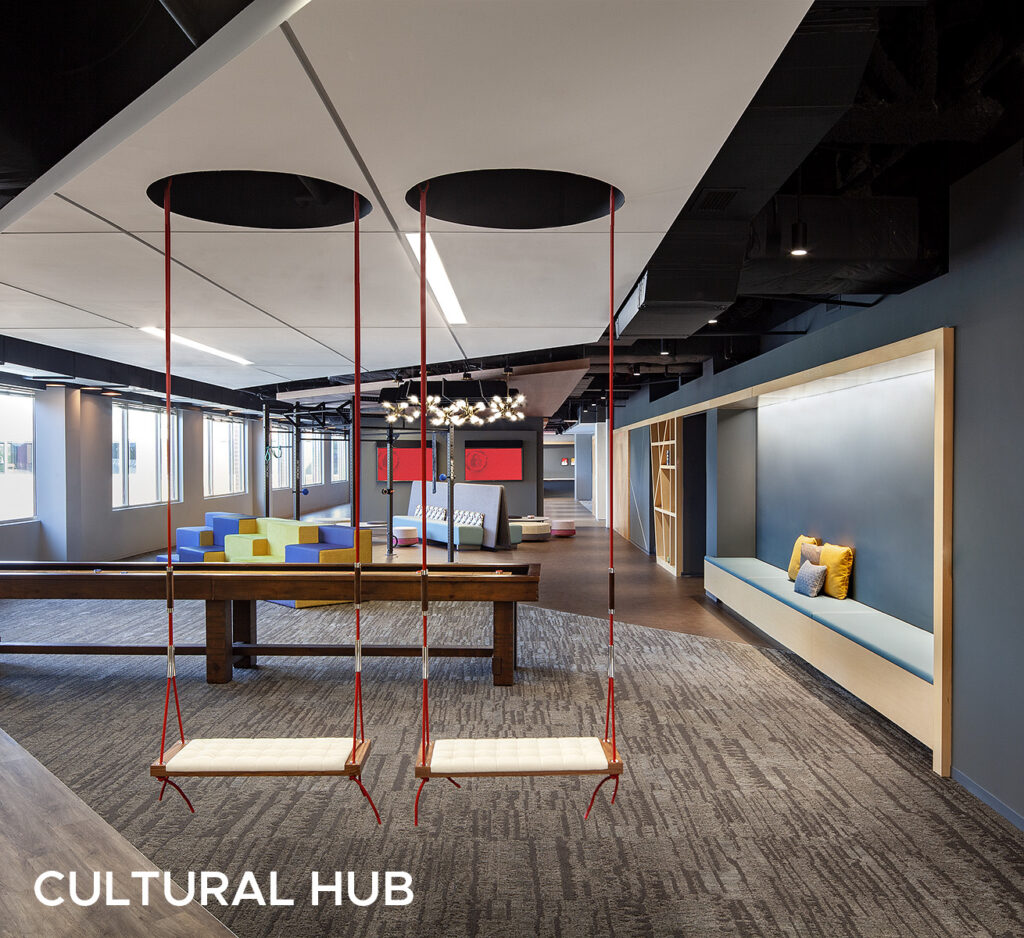
These workplaces aren’t built for one generation or a single moment in time; they’re built to support people now and as their needs evolve into the future.
TECHNOLOGY: SUPPORTING CONNECTION FROM ANYWHERE
With approximately 79% of the U.S. workforce working remotely or in hybrid settings*, technology has redefined how we connect at work. It’s broken down physical barriers and enabled seamless collaboration across teams and time zones. Tools that were once perks, like desk-booking apps and real-time messaging, are now considered essentials.
But constant connection brings a new challenge. When people are always reachable, boundaries blur. What supports collaboration one moment can create digital fatigue the next. That’s where thoughtful design makes all the difference.
Structure supports tech integration beyond adding screens to rooms; it’s about designing environments that enable smooth transitions between virtual and in-person collaboration. That might mean providing tech-equipped huddle rooms, soundproof booths for virtual meetings, reliable AV setups for hybrid calls, or spatial zoning that separates high-traffic areas from heads-down work zones. These choices ensure that technology serves the space, not the other way around.
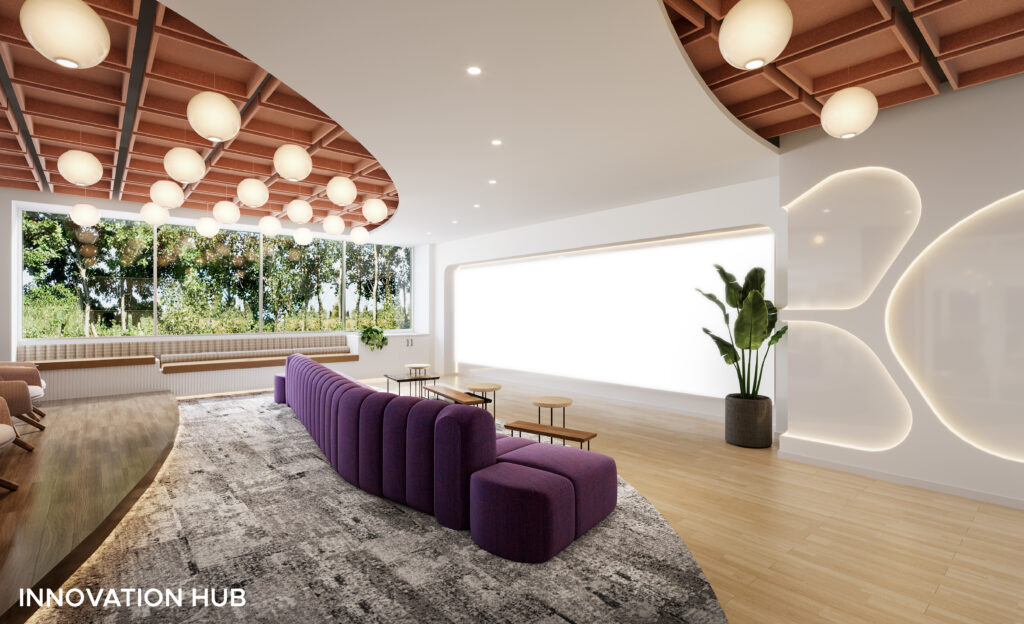
Sense reinforces balance by empowering people to set boundaries like muting notifications or stepping away for screen-free time. It’s a culture that encourages tech use with intention, not expectation.
Technology is everywhere, but that doesn’t mean it’s easy for everyone. While digital natives may navigate platforms instinctively, others bring a different kind of fluency rooted in analog problem-solving and experience. The most effective tools don’t favor one generation over another. They’re intuitive, user-friendly, and supported by training that meets people where they are. Reverse mentorship can be especially influential here, helping teams bridge generational gaps and strengthen shared learning.
Artificial Intelligence has added a new layer. For the first time in decades, every generation is learning something new together. That shared challenge creates common ground and an opportunity to grow as a team. Still, organizations must remain proactive: involving employees in the decisions and choosing tools that simplify work, not complicate it.
When structure delivers accessible, well-integrated systems and sense reinforces thoughtful use through communication and trust, technology becomes a bridge, not a barrier. The goal isn’t to digitize everything. It’s to create connection without disconnection. And true success lies in balance—using technology to enable flexibility without replacing human connection.
EMPATHETIC LEADERSHIP: SUPPORTING PEOPLE THROUGH EVERY STAGE
The workplace isn’t what it used to be, so leadership shouldn’t be either. Today, employees want more than policies and perks; they want empathy. True flexibility begins with understanding. Leaders who acknowledge life’s demands—caregiving, burnout, transitions—can shape environments that are both stable and adaptable.
Empathetic leadership begins with listening. This means designing for the full range of human needs, from connection and collaboration to the realities of stress and recovery. After all, work isn’t all wins and high-fives. People need space to manage stress and everything life throws their way. Structure reflects this reality through adaptable spaces that respond to life’s demands—heads-down focus rooms, social lounges, multipurpose areas that shift with the day, and even wellness rooms that allow for physical and emotional pause.
Just as important, sense is cultivated through open communication, trust, and a culture where every voice matters. Leadership doesn’t live only in top-down decisions. It shows up in everyday moments: a check-in, a thoughtful response, or a willingness to flex based on someone’s real-life circumstances.
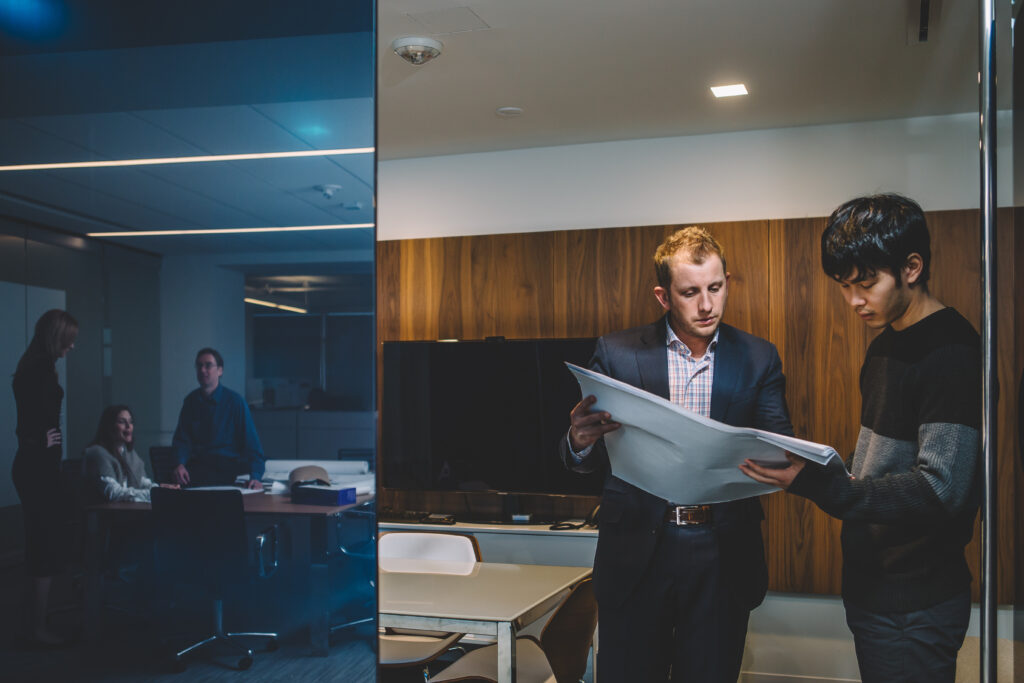
Leaders must respond to generational realities and life stages alike. Some employees are starting their careers, others are nearing retirement. A Gen Z employee may need mentorship; a Gen X parent may need schedule flexibility. Inclusive leadership considers both generational perspectives and age-based priorities.
Empathy also means breaking down barriers. Two-way mentorship, open feedback, and approachability all help flatten hierarchy and build trust. When empathy is embedded in both leadership and the built environment, the workplace becomes more than efficient—it becomes human.
DESIGNING FOR EVERY GENERATION: A WORKPLACE THAT WORKS FOR ALL
Bridging generational gaps isn’t about catering to everyone; it’s about creating a workplace that adapts with intention. Structure supports different workstyles. Sense builds the culture that brings them to life.
From community to technology, privacy to leadership, designing for all generations means viewing difference as strength. There’s no one-size-fits-all solution. After all, no two workplaces are the same. That’s not just because of the different kinds of work being done; it’s because people, the most important asset in any organization, bring distinct strengths and need different kinds of support to thrive. But with the right blend of flexibility and support, workplaces become spaces where everyone feels recognized and set up to succeed.
Human connection, adaptability, and inclusivity aren’t trends; they’re the foundation of a resilient, people-first culture. When structure and sense align, workplaces don’t just keep up with change—they grow with their people and stay prepared for whatever comes next.
*Resources can be provided upon request.
*Resources can be provided upon request.
